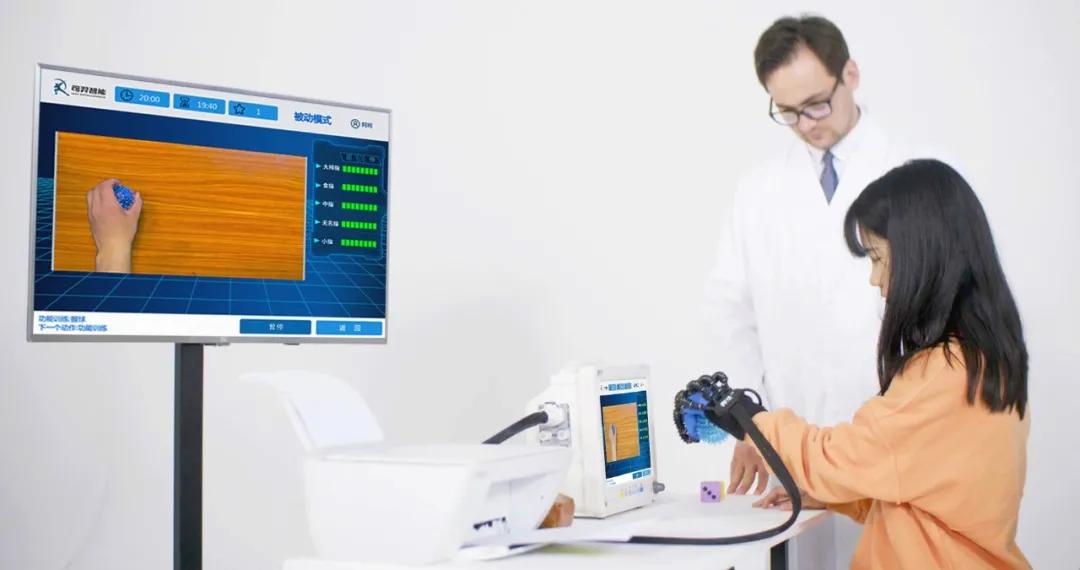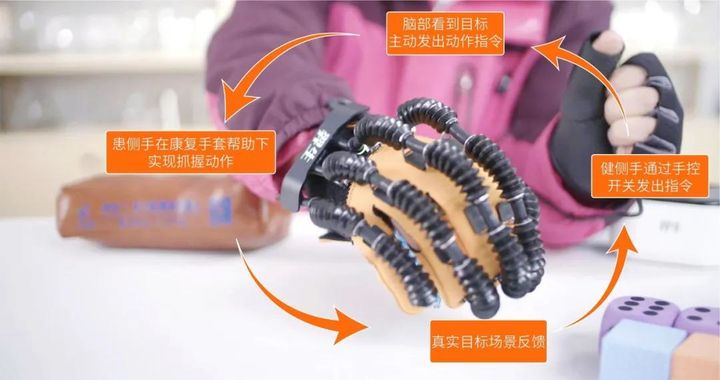Intelligent rehabilitation soft gloves
The software rehabilitation robot glove is an intelligent device for rehabilitation of the hand movement function of stroke patients. It has multiple functions such as master-slave rehabilitation, passive rehabilitation, virtual reality games, and rehabilitation evaluation. Unlike traditional treatment methods that require the assistance of a physical therapist, patients can complete the entire rehabilitation training process independently through software rehabilitation robot gloves, which makes rehabilitation training more convenient and greatly reduces the cost of rehabilitation training.
Smart gloves driven by aerodynamics are connected to the host through a line, and the host can operate the glove in a variety of ways. For example, after a certain mode is selected, the glove can be regularly opened and held tightly under the action of the air pump. After the user puts on the glove, the hand will follow the glove opening and holding under the push of the air pump.

This can replace the work of the rehabilitation therapist, allowing the gloves to open and close automatically, helping patients to train their muscles. In the past, this kind of movement was done manually by professional rehabilitation therapists, who repeatedly helped the patient to open and hold the palm, but now these mechanical movements can be completed by gloves and procedures, which obviously reduces the work of the rehabilitation therapist. quantity. In addition to making fists automatically, smart gloves can also help patients restore neurons. Through training, through sports learning, a neural network can be reshaped. Just like a newborn child who doesn’t know how to grasp his hands, they also use constant exercise and training to shape a neural network to achieve the function of grasping. The mirror system of smart gloves can assist in reshaping the neural network. . Wearing a soft glove device is like putting on clothes. The sensor of the active end glove can accurately capture the movement of each finger of the patient's healthy side. Combined with wireless data transmission, the host then controls the passive glove to assist the affected hand to complete the same action.

Recommended solution: LQ3399 core board
LQ3399 uses RK3399 chip, CPU adopts big.LITTLE size core architecture, dual-core Cortex-A72 plus quad-core Cortex-A53. It has technological leadership in overall performance and power consumption. The GPU adopts the quad-core ARM new generation high-end image processor Mali-T860, integrates more bandwidth compression technologies, and has excellent overall performance. The LQ3399 core board has a dual-channel MIPI camera interface, and there is a dual-channel ISP inside the chip, which can collect two image signals at the same time, and the two-channel data is completely independent and parallel. It can be used in binocular stereo vision, VR and other occasions. With the powerful CPU and GPU resources of RK3399, it is also promising in image processing and artificial intelligence.
Judging from the RK3399 hardware system framework diagram, the open interfaces are extremely rich:
1. Dual USB3.0 Type-C interfaces, supporting Type-C Display Port
2. Dual MIPI Camera interface, dual ISP, single channel maximum support 13 million pixels
3. MIPI/eDP/HDMI2.0 interface, support 4096x2160 display output, dual-screen different display and other functions
4. Built-in PCI-e interface, support PCI-e-based high-speed Wi-Fi and storage expansion
5. Support 8-channel digital microphone array input
6. eMMC5.1 HS400
| specification |
| CPU | • Dual Cortex-A72 + quad Cortex-A53 core CPU structure |
| • Frequency up to 1.8GHz |
| GPU | • Mali-T860 GPU, support OpenGL ES1.1/2.0/3.0/3.1, OpenCL |
| • Support AFBC (frame buffer compression) |
| RAM | • 双通道DDR3-1866/DDR3L-1866/LPDDR3-1866/LPDDR4 |
| • Support eMMC 5.1,SDIO3.0 |
| multimedia | • Support 4K VP9 and 4K 10bits H265/H264 Video decoding, up to 60fps |
| • 1080P Multi-format video decoding (VC-1, MPEG-1/2/4, VP8) |
| • 1080P Video encoding, support H.264, VP8 format |
| • Video post processor: de-interlacing, denoising, edge/detail/color optimization |
| show | • Dual VOP display: resolutions support 4096x2160 and 2560x1600 respectively |
| • Support dual-channel MIPI-DSI (4 lines per channel) |
| • Display support: eDP 1.3 (4 lines, 10.8Gbps) |
| • HDMI 2.0a supports 4K 60Hz display, supports HDCP 1.4/2.2 |
| • Support DisplayPort 1.2 (4-wire, up to 4K 60Hz) |
| • Support Rec.2020 and Rec.709 color gamut conversion |
| interface | • Dual ISP pixel processing capacity up to 13MPix/s, support dual camera data input at the same time |
| • Support dual USB3.0 Type-C interface |
| • Support PCIe 2.1 (4 full-duplex lanes) |
| • Built-in low-power MCU |
| •Support 8-channel digital microphone array input |